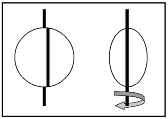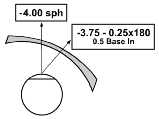|
Everywhere you look these days, you will find consumers wearing sports wrap eyewear. From their unremarkable beginnings as a niche product in the 1980s, the wrap category has grown dramatically. Pech Optical is investing in advanced design and manufacturing technology that has left most old-line eyewear makers behind.
It's easy to understand the popularity of wrap sunglasses. The curved, contoured eight-base polycarbonate lenses in most wraps block UV, shield the wind, reduce glare and protect from impact. They provide excellent optics tailored to all sorts of outdoor conditions, whether cycling, golfing, hiking or fishing. They are designed to be light weight, comfortable and versatile.
You can tell a wrap frame by using a simple protractor method.
Wrap Effects and Optimization
 The curvature and wrap that makes the lens so functional in terms of lens coverage also requires care in setting up the Rx. Compared to a standard "flat" lens in the same Rx, a wrap lens changes the base curve and tilts the lens in the vertical plane. These changes will affect the wearer's vision, not usually for the better, unless the optics are optimized for the effects of The curvature and wrap that makes the lens so functional in terms of lens coverage also requires care in setting up the Rx. Compared to a standard "flat" lens in the same Rx, a wrap lens changes the base curve and tilts the lens in the vertical plane. These changes will affect the wearer's vision, not usually for the better, unless the optics are optimized for the effects of
wrap. Fortunately, the optimization is well understood.
Tilt (Wrap) Optimization
The primary optical effect of wrapping a powered Rx lens is an offset in the prism and power of the lens as perceived by the wearer. The fact that the wearer looks through a lens differently when it is wrapped is key. To consider it another way, if you take an ordinary "flat" lens of a certain Rx power and introduce wrap (faceform tilt), the lens will still read the original Rx only when measured along the original OC and visual axis of the lens. However, in the new wrap configuration the wearer is now looking through the lens on a different optical axis corresponding to the wrapped positioning.
The resulting prism and blur can be objectionable, especially in higher powers. Even a plano lens introduces prism when wrapped, causing discomfort for the wearer; this is why so many ophthalmic manufacturers of better sunwear provide decentered (i.e. prism corrected) lenses in their plano sports eyewear. In an Rx lens, the lens power makes those effects even stronger.
Fortunately, the corrections required to optimize the wrap are fairly straightforward and formulas can be found in many ophthalmic optical texts. The calculation takes into account the Rx power and the wrap dimensions of the frame and the resulting optimization usually adds some base-in prism at the eye point and small adjustments of power, cylinder and axis compared to the original "flat" Rx. These adjustments are ground into the Rx during surfacing.
 In the example opposite, to create a -4.00 sphere for the wearer to satisfy a -4.00 sphere Rx, the lab would need to supply a -3.75 -0.25 x 180 with 0.5s Base In. In the example opposite, to create a -4.00 sphere for the wearer to satisfy a -4.00 sphere Rx, the lab would need to supply a -3.75 -0.25 x 180 with 0.5s Base In.
Please notify us if you would like us to optimize Rx for a wrap frame.
|
